
Deb, Rupert and Jemma
My name is Deb. I have been owned and managed by a Pembroke Corgi or two for almost 16 years now. My first Corgi, Riley, came into my life 21 years after meeting a Corgi for the first time and knowing from that moment on – Corgis were for me! It was only a year and a half later when I thought, hmm, one – why not two? And before you knew it, I got her a “brother”, Rupert. Sadly, I lost Riley to lymphoma of the bowel when she was only 5 years old. This was devastating to Rupert and only weeks after Riley’s passing, Jemma joined us, and they are my Corgi family now. (We also have two cats, or rather I have a cat, and Rupert has a cat.)
Not long after Riley passed away, it came about that I ended up owning and running a Cardigan and Pembroke Corgi web forum. This was in the pre-Facebook days and when breed specific forums were a great venue for people to interact, share, ask and receive advice, and grow friendships. Forums are now sadly being replaced by Facebook, but in all the years I have run it, I have gleaned an awful lot of knowledge from some very experienced and great owners and breeders. I always say, if I haven’t got direct experience with something – I know someone who does.
When Rupert was 10 he had a few issues with his back, which resulted in some on and off mobility issues; pain, weakness and difficulty walking. He was treated with medication, rest and acupuncture quite successfully, but it was becoming clear that while something was getting better, other things were getting worse. Knowing what I do about Pembroke Corgis, I felt in my heart that it was the first tell-tale signs of degenerative myelopathy (DM). Putting together his age (11); the symptoms; the progression and finally a DNA test to see if he was at risk for the disease, it was pretty much confirmed. He is now 3 years into this DM journey, and is still able to get around in a canine cart, not as much, but that’s okay, he still has his spirit that says “let’s go mum!”. I recently decided to have Jemma tested to see if she is at risk – she is almost 11 and has no signs at all, but unfortunately, she also has both alleles that indicate she is at risk. This does not mean that she absolutely will develop the disease.
I have known other Corgis who had DM, but I never thought it would happen to my dog – it shouldn’t – it couldn’t, but it has. It is an overwhelming diagnosis at first, as there is no cure, it is fatal and the progression will mean constant adaptations for both the dog and the caregiver(s). It is a mountain with no joy when you get to the top, at least that’s how it felt to me at first. I immediately turned to the support in the Corgi community, I read the definitive book – and honestly looking at what was coming down the road, I didn’t think I could do it. But that day, when I knew for sure that it was DM, he was still walking – a little bit like a drunken sailor, but he was walking, sniffing, pooping, peeing, chasing the ball, and happy as he always was. I realized that having the knowledge of what the future could hold for him and for me was very important, but that we can’t live every day at the top of the mountain. We aren’t there yet. We just need to live at the level we are on each day as it comes. So that’s what we have done for almost three years. I think that naturally we draw a line in our minds of when we think it will be time to set our pets free from their suffering or struggle. I can tell you that the line will likely move, and it could move forward or back. I honestly didn’t think I could manage Rupert in the stage he is in now – and I didn’t know if he would be okay spiritually at this stage. We get up every day, and we deal with whatever comes our way, and he is mostly happy, he is still “let’s go mum” Rupert, and so we go.
I want to provide you as an owner or potential owner with a little knowledge about some of the mobility issues that you could end up facing with your Corgi at some point. Hopefully you’ll never deal with any of them, but if you do, you will have a little information and be aware of some of the resources available. To me, knowing the health risks of any breed or species of pet that I own is crucial – while I hope they will never come to fruition, I want to be able to manage if they do.
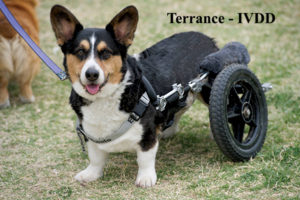 General Information about the Breeds’ Structures
General Information about the Breeds’ Structures
Both the Cardigan and Pembroke Welsh Corgi breeds are dwarf breeds. This means that their joints are different than those in a standard dog. The gene that causes dwarfism (chondrodysplasia) is a mutation that changes the manner and the speed in which the joints develop in order to attain their body structure. As an owner, or potential owner, you must understand what this could mean for your dog from puppyhood and throughout their life. This does not automatically mean they will have issues for sure, but it does mean you have to understand their limitations and abilities and how to manage their lifestyle accordingly.
If you are raising a pup, it’s very important that it be limited in the amount and frequency of high-impact activities; such as agility, stairs, jumping, and jogging until they are a year, to a year and a half old to protect their growth plates. Ensuring that your puppy is growing at a proper rate, and is not growing too big too fast is also crucial so that those joints aren’t damaged.
The body structure puts both breeds at risk for hip and elbow dysplasia and a good breeder will have had the sire and dam’s joints evaluated before breeding to ensure that they are not passing down crippling joint diseases. The Orthopedic Foundation for Animals (OFA) is one resource to research not only these evaluations, but many other genetic health issues that can be passed down through lines.
Cartilage, the connecting tissue between joints, wears down faster in the dwarf breeds and puts Corgis at risk of intervertebral disc disease (IVDD) and arthritis. Arthritis can be present in the spine, shoulders and other joints causing them pain and therefore difficulty in getting around. IVDD can manifest itself in many ways from causing mild discomfort to sudden and complete paralysis.
Both breeds are also at risk for a genetic disease called degenerative myelopathy, DM. The Pembroke has a higher rate of this disease, but the Cardigan Corgi also can carry it. DM is very much like ALS, or “Lou Gehrig’s ”disease in human beings. It is a fatal progressive disease that moves up the spine slowly paralysing them. Again, good breeders should be testing their breeding dogs to do their best to breed out the disease without losing the structure, good health and temperament they have strived to achieve.
You are the most important factor in ensuring that your dog is healthy and happy for its lifetime. While there are some diseases that we have no control over, we do have control over their overall health and ability to manage if something does arise. One of the most important things you can do for your dog is to keep your dog’s weight down. Weight is one of the most important factors in their overall health – it is crucial to keep your dog from getting overweight, as it can be the cause and contribution to many painful diseases. Corgis will do their best to convince you that they are starving, but feeding the appropriate amounts and giving moderate treats is really enough. Food – treats especially should not be how we tell them we love them. There are lots of other ways to give them our attention that are far better for them and us in the long run.
These are not couch potato breeds – oh they will try and tell you otherwise, but don’t be fooled. Cardigans and Pembrokes are moderate exercise breeds, which not only enjoy walks but also free-play like chasing and playing with a ball. A lot of Corgis learn to love water, which is a fantastic way to keep them fit while also being easier on their joints. Keeping them fit, well-muscled, and doing activities that suit their specific body type will go a long way to ensuring they remain mobile and healthy. Even a dog that is at risk of DM can have a longer happier life if they remain trim and physically fit through their lives. It won’t slow the progression of the disease, but it will allow them to remain mobile longer, as the more muscle there is, the longer it will take to atrophy.
At the first sign of limping or pain, get it evaluated by your vet. The sooner any issue is diagnosed, the better the chance of recovery for your dog. Dogs will not generally show you pain until they are really suffering – know your dog, and watch for any behavioural change that might indicate something is wrong.
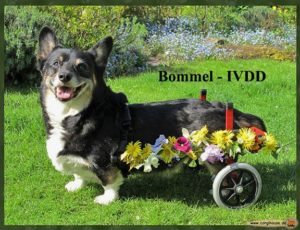 Intervertebral Disc Disease (IVDD)
Intervertebral Disc Disease (IVDD)
The intervertebral discs are small gel-like cushions between the vertebrae that provide shock absorption and stabilization for the spine. When a disc(s) bulges, erupts, or becomes brittle, it can cause anything from mild discomfort to the sudden and complete paralysis of the dog. For most dogs, degeneration happens slowly over their lifetime and it may never have an impact on them at all. Because of the dwarfism, Corgis (both breeds) are not only prone to the age and wear-related form of spinal problems, but they have an additional degeneration that starts in their first year or two of life as they develop.
The Two Types of IVDD
Type 1 is a progressive disorder in which the outer layer of the disc degenerates and the inner cushion (gel) becomes hardened. Eventually the outer layer will break and the hardened interior will press against the spinal cord – it can happen in one or more places in the spine. This degeneration can be seen in dogs as early as 3 years of age, but it isn’t generally seen until the dog is much older. With this type of disease the dog is fine one minute – the dog is down in the rear the next. It comes on very quickly and can be very painful. It is very important to get to a neurologist as soon as possible for surgery. The goal is to try and have the surgery within 48 hours, however it still can be successful if you miss the 48 hour window – so don’t despair. This type of IVDD is something that you as an owner have no control over, it’s either there, or it’s not.
Type 2 is much slower and gradual and leads to the bulging of the inner disk material into the spinal canal. This is similar to what happens to humans – most of us reach a certain age where we may have this same kind of degeneration or bulging of a disc, but unless it is pressing on the spinal cord – or the sciatic nerve, it may never have an impact on our lives.
The symptoms of IVDD can vary greatly and may not even seem to indicate an issue with the spine. Depending on where along the spine the issue is, the dog could have neck or back pain that is indicated by one or more of the following:
- reluctance to walk
- reluctance to go up or down stairs
- reluctance to lift the head or to lower the head to the food or water dish
- tenseness or spasm of the neck muscles, vocalizing (spontaneously or when the neck/head is touched or moved)
- the lifting of a front leg as if something were irritating it
- reluctance to jump on or off furniture
- tenseness in the abdomen
- restlessness
- vocalization
- panting
- sensitivity when playing or when picked up
- belly or tummy pain
IVDD is diagnosed through a thorough physical and neurological exam by a veterinarian. The most common IVDD issues are the bulging (herniating) or eruption of the disc that then impedes on the spinal cord to cause pain, numbness or mobility impairment. While most veterinarians will suggest spinal x-rays to help with the diagnosis, be aware that they are really only helpful when something other than a disc issue is suspected, such as a tumour or a break. Knowing where the disc issue is will only be beneficial if it is surgical and it can tell a surgeon where it is. Discs cannot be seen in an x-ray, and the best diagnostic is really an MRI. Again, if the diagnosis on exam is clearly a herniated or bulging disc, then it may not be necessary to have an MRI in order to treat the dog.
Treatment can vary from simple rest and medications which will allow the disc to go back to where it belongs on its own, to surgery for repair. Pain management and anti-inflammatory medications can help prevent and reverse any damage that might have happened to the spinal cord.
Modern and ancient treatments can also help with healing and pain management. Cold laser therapy and acupuncture are excellent ways to help your dog recover. More and more veterinary practices are offering these types of options for pets.
For dogs with severe injuries, using a canine cart – or doggy wheelchair, during recovery will give the dog the support they need while building back their strength. Think of a cart in the manner that a human would use a walker while recovering from a mobility injury or surgery.
There are very few of us that have the finances to not think twice about money – we all know that cost must come into play when we are making diagnostic and treatment decisions about our pets. Your vet will understand that too. Ask your vet if there is an option to try something less invasive – like rest and steroids to see if there is improvement. It will of course depend on the extent of the injury. Being concerned about what you can afford to do for your dog does not mean you love them any less.
Prognosis and reoccurrence depends completely on the type and severity of the IVDD, how quickly it was treated, the treatment, the ability of the owner to manage the dog, financial resources and of course, the dog. The sooner you aware of an issue and you have it evaluated by a vet, then the better the chances are of helping your dog recover.
Degenerative Myelopathy (DM)
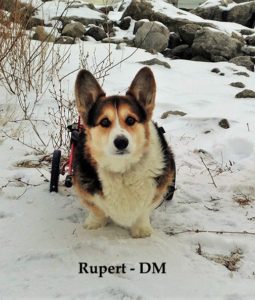 DM is a progressive disease of the spinal cord in dogs causing paralysis to slowly move up their bodies until they would suffocate. As DM generally develops later in life – from 8 years on, dogs often pass away from other diseases or age related issues. DM is incurable, but it is manageable, a dog can have good quality of life for many months after diagnosis with the proper care and devices.
DM is a progressive disease of the spinal cord in dogs causing paralysis to slowly move up their bodies until they would suffocate. As DM generally develops later in life – from 8 years on, dogs often pass away from other diseases or age related issues. DM is incurable, but it is manageable, a dog can have good quality of life for many months after diagnosis with the proper care and devices.
Unfortunately at this time, there is no definitive test to tell you that your dog has DM. It is generally diagnosed by ruling out other neurological disease or injuries, testing the DNA of the dog to see if it has the genes present that would put them at risk, their age, symptoms and progression of the symptoms. IVDD may or may not be ruled out – Corgis can have both diseases, and when they do, it can be tricky to know if it is likely your dog has DM. At some point, the progression and changes will likely make it easier to know.
Testing your dog’s DNA through a simple swab of the inside of their cheek is a good place to start – if your dog is not at risk of DM, then it can likely be ruled out as the cause of their mobility issue. (I have a shark Corgi – anything that goes in that mouth is chomped on, so I asked my vet to assist me, and they were happy to help.)
The DNA test will tell you if your dog has one of three statuses: clear, carrier, or at risk. There are two types of alleles – or mutations of genes that dogs carry, one type is associated with DM, and the other type is not.
If your dog has two of the alleles that are not associated with DM – then they are clear and it is highly unlikely that the dog or its offspring will ever develop DM.
If your dog carries one of each type of allele – then they are carriers and are likely not to develop DM.
If your dog has two of the alleles associate with DM – then they are at risk, and could develop the disease.
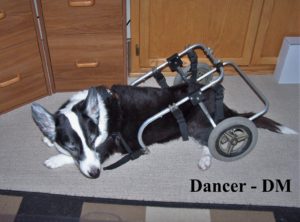 This testing should be done by breeders in order to help eliminate DM, but it should be done in a balanced manner as to not undo the breeding that has eliminated other diseases or to cause structure or temperament to be compromised. DM is more prevalent in Pembroke Corgis, as of December 2015, the OFA was showing 51.9% of Pembrokes tested at risk, Cardigans were 14% at risk. We as “consumers” have the power to help eliminate this disease by ensuring we are asking breeders about their breeding programs and what they are doing to stop DM.
This testing should be done by breeders in order to help eliminate DM, but it should be done in a balanced manner as to not undo the breeding that has eliminated other diseases or to cause structure or temperament to be compromised. DM is more prevalent in Pembroke Corgis, as of December 2015, the OFA was showing 51.9% of Pembrokes tested at risk, Cardigans were 14% at risk. We as “consumers” have the power to help eliminate this disease by ensuring we are asking breeders about their breeding programs and what they are doing to stop DM.
This link will allow you to search the OFA databases for a summary of all of the health data they have for any specific breed: http://ofa.org/stats.html.
The Orthopedic Foundation for Animals (OFA) is the recommended lab for DNA testing and they keep a database of the results of all DNA tests for various diseases where the owners have given permission to publish them. A “kit” will be mailed to you, you swab the inside of your dog’s cheek and “paint” the saliva onto a card and mail it back. It is very simple and non-invasive.
The signs of DM often begin with strange placement of the back feet. You may look at your dog and think why is his/her foot sitting like that or why they are placing it oddly when they walk? You may notice you are hearing your dog’s nails as it walks – if you look at the feet, you may see that the nails on the middle toes are worn further than the others. This is due to “knuckling under”, as the dog isn’t picking up the foot properly and it is dragging. This can happen on just one side, both or switch back and forth.
This slowly progresses into a “wobbly” walk – like it is drunk. Your dog will start having issues getting up and keeping its balance when it is standing. Eventually they will start crossing over their back feet and tripping themselves. If your dog has a tail, it will stop wagging and it may end up getting tangled in its legs. Slowly the dog will lose its ability to stand on its own or walk on its own with its back feet altogether. You may notice that when it is sleeping it is “running” in their sleep, or that they are having jerky, spasmodic movements of the back legs. Once your dog is unable to stand or walk on its own, it is time for a canine cart to support it. It is highly recommended that you get a cart well before they need it and that you get them used to it while they are still reasonably mobile – this will make it much easier to transition them when they really need it.
The DM will continue to move up the spine eventually making the back legs useless and they will be dragging. At some point they can be tied up out of the way, and the wheels will become the back support and means to move. As the weakness moves up, the front wheels will be needed as the front legs become compromised.
Your dog may or may not become incontinent or become unaware of when it is defecating. There are accessories that can help you manage their hygiene needs and your vet can teach you how to express your dog’s urine. If your dog is unable to completely empty its bladder, it will be at risk of urinary tract infections (UTIs) which are more dangerous for older dogs with DM. You may notice that your dog’s bark has changed – that it is more airy and/or high pitched – this is likely that the paralysis is affecting the diaphragm. Your dog will find it more difficult to sit up, and will lay down more. Their head will become harder to hold up and their breathing will eventually be more and more difficult.
There is no definitive timeline as to how and how long the progression will take. There are too many variables. It seems that a dog that is kept as fit as possible during the early stages with regular weight bearing exercise to keep up muscle mass will last a little longer as it will take longer to atrophy. Water therapy will not fight off the disease, but it is a good way to keep your dog fit. Getting your dog out for walks is just as helpful and won’t add any financial burden to an owner.
There are several accessories to help keep your dog’s quality of life up as the disease progresses. Slings, carts, wagons, bellybands, diapers, strollers – are all ways to keep your dog living as close to the way they used to be. The canine cart is probably the best thing for most dogs as it really helps them keep their independence longer. There are several manufactures of carts in the USA and you should decide on what model to buy based on the size and structure of the dog and their lifestyle. As DM is progressive, it is wise to buy the front wheel extension for the cart at the same time, it can save you money and time for when you really need it. You can also purchase a sling to support their rear while they are still able to use their front legs. Other than a few items you may have to purchase to help your dog along the way, DM is not an overly expensive disease to deal with – there are no medications or therapies to treat it.
One of the hardest things we ever have to do is let our pets go. You have to know yourself, any other caregivers and/or family members and your dog. You will have to constantly be evaluating their quality of life and know when it will be time to let humanely let them go.
There are two credos I have always used. I would rather make the decision a week too soon, than a minute too late, and I believe that their last day on earth, should not be their worst day on earth. DM is a terrible way to die.
DM is a daunting journey, but you are not on it alone. There are lots of great resources and forums where you will find knowledge, experience and support. As Cardigans and Pembrokes are dwarf dogs, the resources that are specific to Corgis are recommended. Corgis have many unique needs and quirks that other breeds do not. I can tell you from personal experience that the support, understanding and knowledge from others are the best things you can have at your disposal. I know I could not do this alone, and I don’t feel like I am because of these people.
I highly recommend the definitive book on DM and IVDD “Corgis on Wheels” by Bobbie Mayer. It is available through the CorgiAid website: http://corgiaid.org/cart/corgisonwheels. Most vets do not have in-depth knowledge about DM, and you may want to ask your vet to read the book. My vet really did not have much experience or knowledge about DM and she was willing to read the book early into Rupert’s diagnosis and I am grateful that she did.
Bobbie has also run the Yahoo forum for Corgis with DM and other mobility issues for over ten years – it is comprised of members who have gone through and are going through DM and/or IVDD with their Corgis. The kindness and generosity that the folks in this group share with each other are beyond measure.
https://groups.yahoo.com/neo/groups/wheelcorgis/info?yguid=280117794
There is also the sister group on Facebook:
https://www.facebook.com/groups/57598352536/
Arthritis
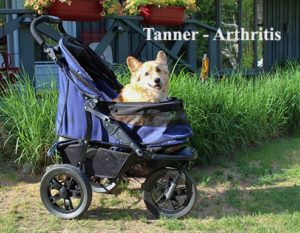
Many Corgis develop arthritis in their joints and spines and it affects their ability to get around. Due to the way their joints develop, it can show up earlier than it might in other breeds. Once again, as an owner you play a part by keeping your dog fit and their weight down. Weight is a major contributing factor to arthritis in dogs and is totally in your control. The severity of arthritis, like IVDD, can vary, but it can progress. Diet, exercise, fish oils and medications to manage the pain can help a dog lead a more comfortable and active life. Cold laser therapy and acupuncture have been shown to be good non-invasive therapies to help manage pain and keep a dog moving well. If the severity of it means a dog is not able to be mobile, then some of the same accessories such as slings, carts and strollers can help a dog remain active.
Amputation
I think amputation is one of the scarier things we as owners can face with our dogs. It seems like such a drastic action and we as humans react with emotion. Dogs don’t react the same way – they are challenged physically as to how they will now get around, but they don’t think oh darn, I will never be the world’s greatest herding dog now.
Whether due to disease, such as cancer, or severe injury, Corgis can manage well with the amputation of a leg. A front leg is harder on a dog’s body, as the weight of a dog is upfront and it puts a lot more stress on the remaining shoulder joint and leg. You have to keep that in mind going forward. Adjusting their exercise and keeping their weight down will help. Activities like swimming will keep them fit without adding stress to the other limbs and joints. Specially outfitted canine carts can be used to “rest” the dog and still give them mobility, or can be used if they are unable to manage later in life with three legs. I had a three-legged cat for many years and he adapted amazingly, in fact he was more trouble than all the rest of the animals put together. My vet has always said that dogs and cats are given three legs and a spare.
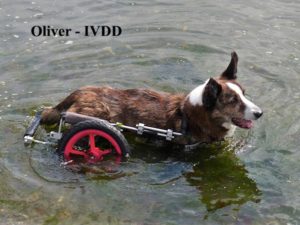 Caregivers
Caregivers
No matter what mobility issue your dog may have, it is important to always remember that they do not have the emotional reaction to it that we do. They live for today. How will I get to my food dish today, how will I get out to play today? They are not lamenting something they may not be able to do in the future. We likely are, on their behalf, and we can be their biggest barrier in going forward and living a fulfilling life. Don’t underestimate what they are capable of. If they have a cart and aren’t off and running right away – don’t give up. They didn’t behave perfectly on their leash the first day either. Give them a chance to figure out, or get accustomed to the tools and accessories that will let them live the lives they are used to longer. And remember – they are Corgis – treats do wonders!
How well your dog will do is dependent on many factors. The degree or severity of their disease or injury, their spirit and personality, their physical environment, your financial resources, your spirit and personality and your physical ability to care for them. Not everyone will be able to go to the same lengths to care for and provide a full life for a dog with a major mobility issue. That’s okay. You know your dog. Give them as close to the life they had before as you can. The walks may be slower and shorter, but as long as you are with them and engaging them, they can be happy and comfortable for a long while. That’s really all they want.
Resources:
CorgiAid has a robust list of resources for mobility impairments of all kinds:
http://corgiaid.org/cart/links.php
Canine cart manufacturers and other accessories:
http://www.corgiaid.org/cart/mfglink.php
The files section of the Yahoo Group “Corgis on Wheels” has lots of tips, ideas and information:
https://groups.yahoo.com/neo/groups/wheelcorgis/files
The breed specific clubs in each country or region has good basic health information on each breed:
USA
Cardigan: http://www.cardigancorgis.com/
Pembroke: http://pwcca.org/
Canada
Cardigan: http://cardigancorgi.ca/
Pembroke: http://www.pembrokewelshcorgis.ca/
United Kingdom
Cardigan: http://www.cardiganwelshcorgiassoc.co.uk/
Pembroke: http://www.welshcorgileague.co.uk/